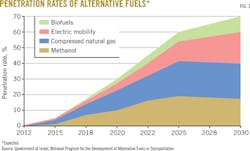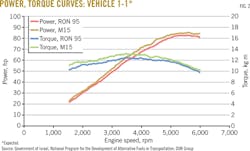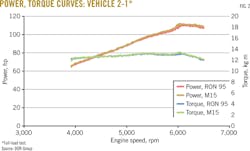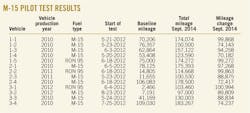Methanol proves low-cost, sustainable option for gasoline blending
David Netzer
Consulting Chemical Engineer
Houston
Joseph Antverg
Dor Chemicals Ltd.
Haifa, Israel
Gideon Goldwine
Consultant
Tel Aviv
Following the discovery of large natural gas reserves in the eastern Mediterranean offshore (OGJ Online, Nov. 7, 2011), the Israeli government in 2011 implemented its Fuel Choices Initiative (FCI), a program designed to encourage the economic and sustainable development of natural gas-based transportation fuels to reduce the country's dependence on imported crude oil products.
Under the supervision of a government steering committee and with financial support from Israel's government, Dor Chemicals Ltd., Haifa, committed to undertake two stages of pilot field testing to characterize fully the effects of using methanol as an additive to petroleum-derived fuels in existing gasoline-powered vehicles.
Test results, which will serve as a basis for Israel's emerging national fuel policy, indicate methanol, at certain concentrations, can act as a low-cost, clean-burning, high-efficiency, and high-performance blending stock for gasoline, allowing the country to monetize abundant natural gas resources whose development has been constrained by geopolitical problems.
In addition to examining the chemistry, economics, and environmental performance of methanol's historical use as a motor fuel, this article uses the results of Dor Chemicals' pilot study to evaluate the potential for methanol-gasoline blending as an option for North America's surplus shale gas supplies.
Overview
While the use of alternative fuels for transportation has been considered for many years, for any such fuel to become a practical substitute to conventional gasoline, it must be abundant and economically competitive.
As of 2012, global gasoline consumption stood at about 23 million b/d, all of which has been supported by an existing infrastructure tailored for the transport of liquid fuels.1
Sold in the commodities market at a transparent market price, liquid in all ranges of ambient temperatures, and a carbon-based energy carrier with a lower density than gasoline, methanol has been used intermittently by countries around the world as a viable alternative to conventional, petroleum-derived fuels.
With a global production of more than 70 million tonnes/year, methanol can be produced from many sources, including natural gas, coal, petroleum coke, organic waste, as well as heavy liquid residue from petroleum refining.2
As opposed to gasoline, which is a mixture of hundreds of different fractions of chemicals, methanol consists of a single molecule, which as fuel offers advantages in the designing and building of internal combustion engines as well as in fuel-injection systems.
With its high octane number, methanol also provides ignition properties that can increase the thermal efficiency of an engine as well as lower a vehicle's tail-pipe emissions.
Mixtures of methanol with gasoline, then, can support a higher-octane fuel at reduced prices compared with conventional, straight-run gasoline.
Just as ethanol does, however, methanol has a lower volatility compared with conventional fuel, which encourages its blending with gasoline to support engine start-up, even at low ambient temperatures.
History
Methanol's history as a transportation fuel stretches as far back as World War II, when Germany used supplies produced from coal. Later, the rush to develop alternative motor fuels following the 1970s global energy crisis resulted in wider applications of methanol-based fuels.
The biggest implementation of methanol during this period occurred in California, when the state instituted a program using the M-85 (85% methanol and 15% gasoline) blend at fuel stations for a fleet of about 21,000 M-85 dedicated vehicles.
California abandoned the M-85 program, however, when oil prices once again stabilized.
Since the early 1980s, EN 228, a directive of Comite Européen de Normalisation (CEN), the European standards organization, has allowed up to 3% methanol blending into gasoline (OGJ, Jan. 25, 1993, p. 24).
While the fuel standard remains valid for Europe, regional refiners still rarely mix methanol with gasoline.
The widest adoption of methanol-gasoline blending has occurred in China, where rising supplies of domestic methanol-most of which is produced via gasification of coal-as well as substantial quantities imported from the Middle East have been used as an automotive fuel mix during the last decade.3
At present, more than 5 vol % of China's national gasoline consumption can be attributed to methanol. In some provinces, however, the percentage is substantially higher.
While China's overall methanol-gasoline blend can range from 5 vol % up to 85 vol % methanol, the most common blend contains 15 vol % methanol and 85 vol % gasoline.
Chinese government authorities as well as industry groups in the country have developed strict guidelines and standards for methanol-gasoline blending, which include standards related to engine performance, corrosion, and vehicle emissions.
In Australia, which currently is a net exporter of natural gas, Coogee Chemicals, Kwinana, Western Australia, is developing and conducting trials of gasoline-ethanol-methanol blended fuel mixtures as a way to reduce the country's reliance on imported petroleum-derived fuels by making efficient use of its own domestic resources.4
Legislation
In the past, especially when carbureted engines represented the majority of motor vehicle fleets, oxygenated hydrocarbons such as methyl tertiary butyl ether (MTBE) were added to gasoline to boost octane ratings as well as to suppress tail-pipe emissions, including carbon dioxide, nitrogen oxide, and miscellaneous light hydrocarbon ozone-smog inducers.5
While the use of MTBE initially was banned or restricted by several US states, these restrictions combined with the reformulated gasoline (RFG) mandate to create market forces that led to the complete elimination of MTBE for gasoline blending in the US.6
MTBE, however, remains widely used as a fuel additive in the rest of the world, including Europe and Israel.
The issue of boosting octane simply became a matter of economics, in which refiners evaluated high-octane blending components vs. alternative methods of raising octane levels, such as catalytic reforming of heavy naphtha, isomerization of light naphtha, and alkylation of butylene (C4) olefins with isobutylene (iso-C4) to produce iso-octane.
In more recent years, ethanol, MTBE's primary substitute, was introduced as a 10 vol % blending component for gasoline in the US, initially on voluntary basis and later as a means to conform to the 2007 Energy Independence and Security Act (EISA), now enforced by the US Environmental Protection Agency.7
According to EISA, grounds for ethanol blending in US gasoline include:
1. Reduction in ozone-forming intermediates from tail-pipe emissions.
2. Reduction in "greenhouse gas" since, by EPA methodology, ethanol is 21-22% renewable and could result in a 21-22 % reduction in greenhouse gas emissions relative to gasoline.
3. Energy security of the US by generating homegrown oxygenates such as ethanol via fermentation of corn.
4. Agreement of US legislators that future cellulosic ethanol production, perhaps 85% renewable, could further increase the merits of ethanol blending.
To mitigate the issues of elevated rvp, the US Congress and EPA issued a series of rvp waivers, which allowed for an additional 1.0 psi in conventional gasoline blended with ethanol as well as limited ethanol blending to 10%.1 8
Despite its wider acceptance abroad, methanol-gasoline blending has been debated for decades in the US. Major objections to methanol-gasoline blends have included:
1. Renewability factor as a cause for climate change.
2. Assumed toxicity of methanol vapor from fugitive losses.
3. Methanol leakage and safety issues related to transportation.
4. Methanol-gasoline leakage to ground water.
5. Solubility of water in methanol.
6. Biological degradation of methanol.
7. Elevated rvp of gasoline-methanol blends.
A variety of different tests, studies, and research, however, has indicated that the above objections are baseless.9
While EPA has since issued waivers on methanol-gasoline blending in the US, refiners infrequently have invoked their use, likely due to existing vehicle warranty agreements issued by US automobile manufacturers that indicate a reluctance to honor such warranty in the event a motorist uses a methanol-gasoline blend.
DOR's pilot program
Following the launch of FCI in 2011, the government of Israel allocated a budget of about $430 million to support the program over a decade to allow enough time for the country to establish an attractive investment environment to spur development of alternative fuel penetration under three different spheres, including fuel types, motor vehicles, and infrastructure.
Fig. 1 illustrates the government's targets under FCI for replacing domestic transportation fuels in Israel.
DOR Chemicals began pilot testing in 2012 after the government determined one of the most favorable ways to reduce the country's reliance on conventional fuels was the use of methanol as a gasoline-blending component, or gasoline replacement, in internal combustion engines.10
The pilot program consisted of a field test with 13 unmodified vehicles from 3 different manufacturers, 10 of which were fueled with M-15 (15% methanol, 85% gasoline), which has no vapor-pressure deviation from the Israeli and European standards. The remaining 3 vehicles, which served as a control group, were fueled by standard RON 95 gasoline.
Before the start of testing, nine engines were dismantled for inspection and measurement of various parts, with the same procedure to be repeated at the end of the test after mileage accumulation.
During the test program, the engine oil of all vehicles was analyzed three times per cycle by an independent laboratory, with all vehicles serviced according to manufacturer orders at manufacturer-authorized service stations. The vehicles were fueled in regular public fueling stations where one of the tanks and dispensers stored and dispensed M-15 using standard gasoline equipment.
The M-15 fuel mixture was prepared in DOR's facilities and tested by an independent laboratory according to the fuel standards in Israel.
During the field test, compatibility tests were performed for various metallic, elastomeric, and plastic materials used in various parts of the vehicle's fuel systems as well as at the fueling infrastructure.
The vehicles were driven for a total of more than 1 million km (about 621,000 miles) by ordinary drivers under normal, daily driving scenarios in both urban and rural settings.
Engine technology used by vehicles in the test consisted either of port fuel injection (natural aspiration) or direct injection (turbocharged).
All vehicles underwent chassis dynamometer tests for engine power and emissions both at the beginning and end of the test program.
DOR also will undertake another pilot test using flexi-fuel vehicles (FFV) fueled with M-56 (56% methanol, 44% gasoline), which is scheduled to begin in the near future.
The accompanying table shows the results of the M-15 pilot test.
Results of the M-15 pilot test strongly suggest the viability of using M-15 as a conventional transportation fuel in regular vehicles without negative impacts to drivability or emissions.
There are numerous reports that methanol-gasoline mixtures with a low percentage of methanol do not affect, or even reduce, emissions.11
Figs. 2-3 illustrate the results of comparing the full power and torque of both M-15 and RON 95-fueled vehicles used in the pilot test.
Drivability might be affected if the energy density is much lower compared with gasoline. In this respect, it is worth noting that normal variance in energy density of gasoline is in the order of ± 3-4%, depending on specific gasoline-blending components. A slight decrease in energy density of M-15 as compared with gasoline can be tolerated by all modern vehicles, which are equipped with fuel-injection systems.
For FFVs, which were designed to be driven either on pure gasoline or E-85, the target fuel is M-56, which has the same energy density as E-85. Material compatibility of M-56 fuel, however, cannot be determined until that pilot test has been completed.
In addition to DOR's pilot testing program, the Israeli government also is conducting joint research with a certified European independent vehicle emission laboratory for further testing of emissions and fuel economy in vehicles fueled by methanol-gasoline mixtures.
While M-15 emissions tests under this program are nearing completion, FFV testing is still in its early stages.
Infrastructure issues
As noted, transportation of methanol is handled similarly to that of gasoline, with regular distribution occurring via pipelines, barges, road tankers, and railcars. It is shipped in conventional products tankers and stored in floating-roof, carbon-steel tanks. Any existing tank currently used for gasoline can readily and rapidly be adapted for methanol delivery and storage.
While methanol is a bit more corrosive than gasoline, no storage or transportation problems occurred during any phase of the pilot program.
During DOR's tests, gasoline-methanol blends were distributed via existing gasoline infrastructure without the necessity for any modifications. Infrastructure used during testing included gasoline terminals, road tankers, and all service station components, such as underground tanks, pumps, dispensers, and vapor recovery systems.
Introducing alcoholic fuel mixtures into the fueling infrastructure, however, could require some modifications. While most equipment used at fueling stations included in the pilot program were compatible with M-15, surveys and testing conducted during the tests showed that a handful of parts were constructed from materials incompatible with the fuel blend. These parts, instead, had variants built from materials that are compatible with alcoholic fuel mixtures, making them E-85 compatible.
Methanol-gasoline blends are sensitive to phase separation in the presence of water. The use of a small amount of cosolvent, however, can prevent this phenomenon, as mentioned previously. No single-phase separation occurred during DOR's tests.
As with most gasoline and other alcohol-fuel blends, inhibitors or additives (such as anticorrosion agents, special lubricants, and detergents) are recommended during use of methanol-gasoline blends. During the test program, DOR used an additive that was specially prepared for this application.
In addition and in parallel to DOR's field tests, other tests were completed in specially authorized laboratories to check for any signs of phase separation, metals corrosion, as well as for any signs of impacts on elastomers, rubber, and plastics that were exposed to different gasoline-methanol blends.
The future
Results of DOR's pilot tests on methanol-gasoline blends in Israel suggest methanol can provide at least a partial alternative to the exclusive use of conventional or reformulated gasoline, particularly for regions with abundant but seemingly stranded supplies of natural gas, such as the US.
While the economics of any necessary modifications required to accommodate the use of single-molecule, oxygenated fuel as an alternative to conventional gasoline will, of course, have to be evaluated case-by-case, the ability to satisfy regional energy demand with readily available, domestic natural resources provides strong economic incentives of its own.
Based on the methanol-gasoline pricing ratio as of early January 2015, at least in the US, replacing conventional gasoline with methanol is an economically marginal proposition. Based upon historical methanol-gasoline price ratios, however, a reduction of about 20% in unit energy costs could be achieved depending on the relative and fluctuating cost ratio of crude oil, as well as other global market factors, which include the business cycle of methanol's chemical derivatives.
Additionally, new technologies leading to a more economical recovery of shale gas currently employed in North America and emerging in China, Europe, and the rest of the world, would suggest shifting market forces that could further reduce the caloric cost ratio of methanol-gasoline blending.
To date, China is moving forward in securing its current energy demand by converting its domestic coal supplies into methanol, while several locations in North America are considering plans to convert petroleum coke into methanol.
Like the ongoing geopolitical hurdles over infrastructure faced by Israel as it evaluates what to do with its growing supplies of natural gas once future development exceeds deliverable demand for itself and its neighbors, US producers face a similar situation as domestic natural gas production resulting from shale development remains on the rise (OGJ Online, Jan. 22, 2015; Apr. 7, 2014, p. 42).
While not an ultimate solution to ensuring domestic energy efficiency, Israel's current work to evaluate the economic feasibility and sustainability of methanol-gasoline blending does lay the groundwork for further exploration into avenues for "refining" constrained natural gas resources into a form that leads closer to achieving a more secure and prosperous energy future.
References
1. "World Consumption of Motor Gasoline (Thousand Barrels Per Day)," US EIA, International Energy Statistics. www.eia.gov/cfapps/ipdbproject/iedindex3.cfm?tid=5&pid=62&aid=2&cid=regions,&syid=1984&eyid=2014&unit=TBPD.
2. "Driven by China, Global Methanol Demand to Rise Nearly 80 Percent by 2023; North America Marks Return as 'Production Powerhouse,'" IHS Inc., Englewood, Colo. Press release, Aug. 29, 2014. http://press.ihs.com/press-release/chemicals/driven-china-global-methanol-demand-rise-nearly-80-percent-2023-north-americ.
3. "Methanol Blending in China - Trip Report," Institute for the Analysis of Global Security, Potomac, Md. Undated brochure. www.iags.org/Shanxi_trip_report.pdf.
4. "Emerging Opportunities," Coogee Chemicals, Coogee Chemicals, Kwinana, Western Australia. www.coogee.com.au/Emerging-Opportunities.
5. Kinner, N.E., "Fate, Transport, and Remediation of MTBE," testimony before the US Senate Committee on Environment and Public Works, Apr. 23, 2001, Bedrock Remediation Center, University of New Hampshire, Salem, NH. www.epw.senate.gov/107th/kinner.pdf.
6. "State Actions Banning MTBE (Statewide)," US EPA, Report EPA-420-B-04-009, June 2004. www.epa.gov/mtbe/420b04009.pdf.
7. "Laws & Regulations: Summary of the Energy Independence and Security Act," US EPA. http://www2.epa.gov/laws-regulations/summary-energy-independence-and-security-act.
8. "Waiver Requests Under Section 211(f) of the Clean Air Act, Revised August 29, 2013," US EPA, Report EPA-420-B-13-041, August 2013. http://www.epa.gov/otaq/fuels/registrationfuels/documents/420b13041.pdf.
9. Netzer, D., and Wallsgrove, C., "Petcoke & Methanol-2 (Conclusion), How blending petcoke methanol into gasoline might work," OGJ, July 4, 2011, p. 90.
10. "Methanol," Dor Chemicals. Ltd., Haifa, Israel. www.dorchemicals.com/eng/family/Methanol?catid=Dor-Chem_Methanol.
11. Zhao, H., Ge, Y., Tan, J., Yin, H., Guo, J., Zhao, W., and Dai, Peipei, "Effects of different mixing ratios on emissions from passenger cars fueled with methanol/gasoline blends," Journal of Environmental Sciences, Vol. 23, Issue 11, November 2011, p. 1831-38.
The authors







